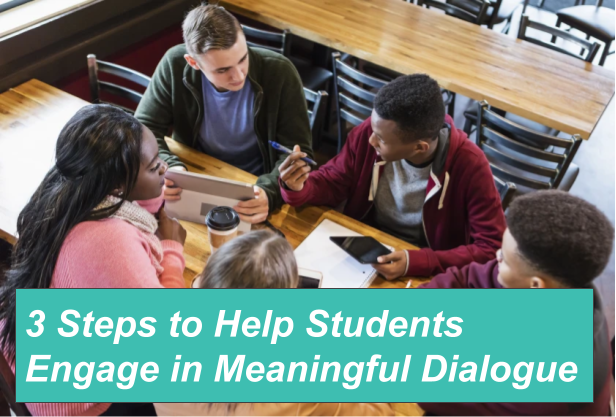3 Steps to Help Students Engage in Meaningful Dialogue

When considering classroom equity, we’re using the National Equity Project’s1 definition of educational equity: when each child receives what they need to develop to their full academic and social potential. But how can we tell how well we’re fulfilling this mission? What evidence can we point to?
One option is to take stock of how often our students feel safe enough to speak up in our classrooms - and not just about the trivial things, but the important stuff, too. How often do they take intellectual risks? How often do they ask other students questions? How amicably do they debate? In a recent blog post, we mentioned Spider Web as one possible classroom discussion strategy. Today, I’d like to share a few steps we can take to create classrooms safe enough for meaningful student dialogue.
Establish Discussion Norms, Then Practice Them Over and Over!
If you’re like me, you’ve always wanted a math classroom where all students feel comfortable enough to share their thoughts and opinions. It makes all of us better when we’re all contributing. What most of us quickly learn, though, is that simply announcing that our class is a safe space for sharing isn’t nearly enough.
Matthew Kay, author of Not Light, But Fire2 writes, “We can no more punish our way into a conversational safe space then we can conjure one from thin air - so we must instruct where we used to admonish, encourage where we used to excoriate, and carefully track what we used to ignore.”
Kay’s book includes many helpful tips for establishing what he calls “dialogic” classrooms, including the importance of establishing simple discussion norms. Here are the three that Kay uses:
- Listen patiently - we don’t interrupt others and we don’t raise our hand when someone else is speaking
- Listen actively - We seek to understand what our classmates are saying so we can learn from, support, build upon, or challenge their ideas (you could have students use notebooks where they are encouraged to write down classmates' thinking and build upon it)
- Monitor your voice - we speak to everyone, not only the teacher, and we speak succinctly, being aware of how much conversational space we’re taking up
While I really like Kay’s norms, they certainly aren’t the only ones3. The key is to choose norms that we can consistently refer to as we build the capacity for meaningful discussion in our classrooms. Building a culture around discussion norms takes practice, more practice, and even more practice.
It’s also important to aim for simplicity. If our norms are too lengthy or too complicated, it becomes difficult for students to remember them and for us to refer to them.
Before You Respond, Wait!
Wait time is not a new idea, but oh boy is it something most of us need to keep reminding ourselves to practice. Whenever I watch a recording of myself teaching, I’m always shocked by the difference between my perception of how long I wait (feels like 5 minutes) and the reality of how long I wait (more like 2 seconds).
Research4 suggests that the value of wait time for our students is 3-fold:
1. An increase in the number of student-to-student conversational turns during a class discussion
2. An increase in the number of evidence-based responses before and after students make inferential statements
3. An increase in confidence in student responses as measured by voice inflection instruments
More student-to-student talk, more confidence, and more evidence? Yes, please! This is an equity strategy that doubles as a mastery strategy. And the best part is that all of these results are based on a wait time of only 3 seconds or more (but seriously, record yourself, because 3 seconds feels like forever)!
Consolidate from the Bottom
Now that we’ve discussed how we’d like students to engage in dialogue (discussion norms) and how we can give all of our students a chance to speak by allowing them time to think and process (wait time), let’s rethink one of the bread-and-butter math teacher practices: how we “go over” student work. Going over a task in order to help students make connections to broader concepts is what Peter Liljedahl calls consolidation5. He argues that, while most teachers see consolidation as a chance to “level up” our students by going through the most challenging practice problems, we really ought to use these opportunities to reinforce the basic foundations by starting with the concepts we want all students to understand. He calls this consolidating from the bottom.
It just so happens that consolidating from the bottom is an equity strategy, too, that can help all of our students engage in meaningful dialogue. Consider, when we use our scarce consolidation time to focus only on the most complicated or nuanced aspects of the solution, how many do we unintentionally push away from the discussion? It can be difficult to engage or even feel like a part of the class when the teacher goes through practice problems that a student didn’t understand or never tried. Starting from the bottom makes it more likely that our students stick with us, contribute to the discussion, and better understand the challenging concepts when we get there.
Discussion norms, wait time, and consolidating from the bottom are ways we can help our students build the capacity for meaningful dialogue. Whether you use the specific strategies mentioned here or others, our intentionality toward helping students feel safe enough to speak with courage and vulnerability will help make our classrooms more equitable places.
Pete Grostic, Ph.D
Executive Director
Please join Math Medic Foundation in our mission to improve math outcomes for all. You can contact us to get involved or donate here.
Follow us on Twitter!
2 Not Light, But Fire - Matthew Kay
3 Establishing Norms in the Math Classroom
4 Rethinking Wait Time - What Can 3 Seconds Do?
5 Building Thinking Classrooms - Peter Liljedahl
04/03/2023